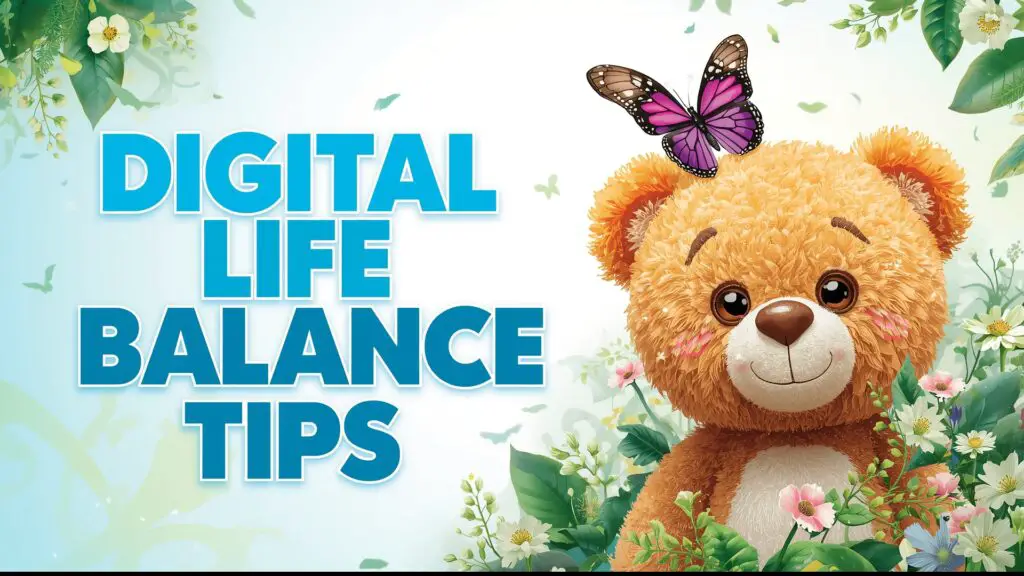In today’s digital world, our lives revolve on screens. From morning emails to continuous scrolling at night, technology has been intimately intertwined into our daily habits. While digital technologies have made life more easy and connected, they’ve also presented a unique challenge—digital overload. The incessant buzz of notifications, the draw of social media, and the push to stay online 24/7 can interrupt sleep, increase stress, and steal vital time from real-life connections.
That’s why attaining digital life balance is crucial. This means utilizing technology mindfully—so it supports your objectives, relationships, and well-being rather than overpowering them. In this post, we’ll discuss the importance of digital life balance, its advantages, and practical methods to help you reclaim control in a screen-saturated society.

What Is Digital Life Balance?
Digital life balance refers to the intentional management of time spent on gadgets and online platforms. It’s about ensuring that technology enhances your life instead of distracting from it. Achieving balance doesn’t mean shutting off technology altogether. Instead, it means setting healthy boundaries, being present in the moment, and choosing quality digital engagement over quantity.
Why Digital Balance Matters
1. Mental Clarity and Focus
Constant multitasking between apps, tabs, and communications scatters your attention. Reducing digital distractions increases focus and deep thinking—boosting productivity and creativity.
2. Better Sleep
Too much screen time—especially before bed—disrupts melatonin production and decreases sleep quality. A balanced digital habit supports pleasant sleep and enhanced health.
3. Healthier Relationships
When screens dominate discussions, personal relationships deteriorate. Limiting phone use at meals, social activities, and family time helps improve human bonds.
4. Reduced Stress and Anxiety
Endless notifications and social comparison on digital sites can increase anxiety. Practicing digital health helps alleviate strain and develops emotional stability.
5. More Free Time
Tracking your screen usage typically exposes hours lost to aimless scrolling. Reducing screen time frees up energy for hobbies, mobility, and real-life joy.

10 Practical Tips for a Balanced Digital Life
Here are 10 proven, human-centered tips to help you establish a good balance between your digital and real-world life:
1. Set Digital Boundaries
Create precise time limitations for social media, gaming, or work-related apps. Use tools like screen time settings or app blockers to keep yourself accountable.
Pro Tip: Start with a 30-minute daily limit for non-essential apps and adapt from there.
2. Follow the “No Screen Before 9 or After 9” Rule
Avoid using screens the first hour after waking and the last hour before sleeping. These digital-free zones are great for self-reflection, journaling, stretching, or meaningful interactions.
3. Practice the 20-20-20 Rule
To prevent digital eye strain, every 20 minutes, glance at something 20 feet away for 20 seconds. This easy practice can prevent headaches and exhaustion after long screen sessions.
4. Turn Off Non-Essential Notifications
Do you really need to know every time someone likes your post or sends a meme? Turn off unwanted notifications to decrease digital clutter and reclaim mental tranquility.
5. Designate Tech-Free Zones
Create spaces in your home where electronics are not allowed—like the dining table, bathroom, or bedroom. These zones inspire mindfulness and stronger real-life interactions.
6. Do a Weekly Digital Detox
Take one day a week—or even just a few hours—completely free from screens. Use this opportunity to connect with nature, read a book, or spend quality time with loved ones.
7. Audit Your Apps
Go through your phone and eliminate any apps that don’t offer value to your life. Keep only what serves a clear purpose or offers true joy.
8. Schedule Offline Activities
Actively plan pastimes that don’t involve screens. Try gardening, painting, journaling, yoga, or even simply a thoughtful walk. These activities restore you to the present moment.
9. Use Technology Intentionally
Before accessing an app or website, ask yourself: “Why am I doing this?” If you can’t answer, you might be utilizing electronics out of habit or boredom.

10. Be a Role Model
Whether you’re a parent, partner, or friend, your digital behaviors effect others. Lead by example—show that life offline may be just as rich and meaningful.
The Future Is About Balance, Not Withdrawal
Digital technologies are here to stay—and that’s not a negative thing. Smartphones, social media, and streaming services may enrich our lives when used responsibly. The trick is to take back control. Rather than letting technology dominate your life, use it with intention.
Remember: Your time and attention are valuable. Every moment spent gazing at a screen is a moment not spent living fully. Digital balance isn’t about perfection—it’s about awareness, moderation, and mindfulness.



